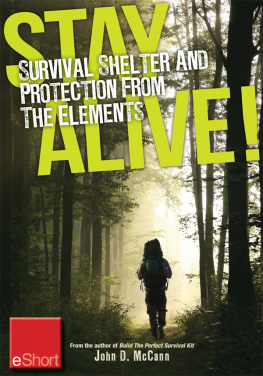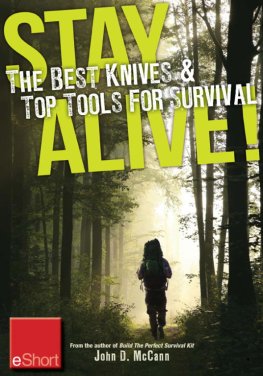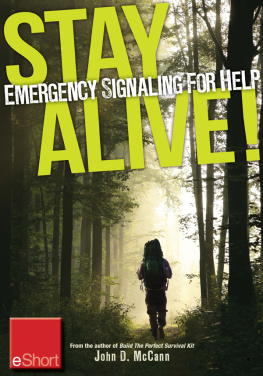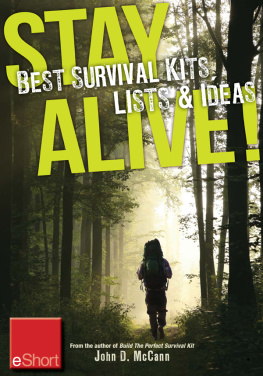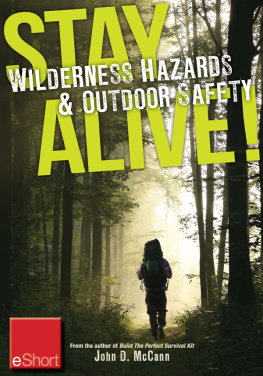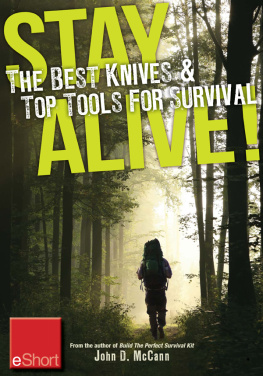Stay Alive: How to Start a Fire without Matches (eShort)
Discover the best ways to start a fire for wilderness survival & emergency preparedness.
By John D. McCann
One of the most important skills in a survival situation is the ability to successfully start a fire. A remarkable array of benefits result from fire. It produces heat and provides light so you can continue activities when it becomes dark. You can dry your wet clothes. Both the light and smoke of a fire can be used to signal your location to searchers. Fire boils water to purify it for safe drinking. It also provides a means to cook in order to make food safe to eat, or more palatable. One overlooked benefit of fire is a sense of companionship, a friend in the dark that repels the noises of the night. Fire provides comfort and is a morale builder.
Although man has been making and using fire for thousands of years, what exactly is fire? Lets take a look at the technical aspects of fire, as it will help you better understand how to create it. After all, that is the skill you need to master.
According to the American Heritage Dictionary, fire is a rapid, persistent chemical change that releases heat and light and is accompanied by flame, especially the exothermic oxidation of a combustible substance. A real mouthful, but what does that really mean?
Fire is a chemical process. In order for this process to occur you must have oxygen, heat and fuel, often referred to as the Fire Triangle. If you do not have all three elements, a fire cannot start or be sustained.
To make a fire, we need air, which is the source of oxygen for the fire. How many times have you seen someone fan a fire, or blow on it, to keep it going? That is oxygen being added to the heat and fuel to keep the oxidation process going. On the other hand, if you smother a fire, it will go out. No oxygen, no fire.
The heat can be generated by various means, including a spark, a hot ember or the concentrated beam of the suns rays.
Fuel can be anything that is combustible. In a survival situation that will usually be some sort of tinder, like shredded bark, or other type of natural material (more on that later) that has a low flash point, followed by wood (if available) to maintain the fire.
If you have an adequate amount of oxygen, you must apply an adequate amount of heat in order to ignite the fuel. When the fuel is raised to its ignition temperature, combustion occurs and you have fire. Once a fire is started, it can be sustained as long as the three elements are maintained.
Site selection & preparation
Before we get into actually making fire, lets begin by discussing site selection and preparation. When looking for a suitable site, try to locate an area that is flat and is protected from the wind and rain.
Whenever possible, fire making materials should be close at hand. Dont build your fire in an area where you must go and collect fuel and lug it back to the fire location. Build your fire as close to your shelter as safety allows. Too close will threaten you and your shelter; too far and no warmth is gained. When possible, build a reflector to direct heat from the fire towards your shelter.
Wherever you build your fire, clear flammable debris from a good three-foot circle or more around the fire location. Remove all leaves, brush, roots and other flammable litter. If there is snow on the ground, build a platform from green wood to start your fire on. If the snow is deep, remove as much as you can before building the platform.
To construct a reflector, pound two vertical uprights in the ground (about the width of the fire apart), leaning them slightly away from the fire, and stack small green logs horizontally on top of each other. You might need more vertical uprights in front of the horizontal logs to keep them from rolling off each other. Build this reflector on the back side of the fire, opposite of you. You can also build a reflector using rocks, if available. Make a three sided enclosure leaving the front, towards you, open. Either of these reflectors will help reflect heat back towards you.
Tinder, kindling and fuel
Dont wait until you start the fire to think about gathering fuel. Collect it all before you begin. Fuel consists of tinder, kindling and fuel (bulk firewood).
Great choices for tinder include cotton balls with petroleum jelly, Tinder-Quick Fire Tabs and WetFire Tinder.
Tinder - manmade
Tinder is any type of small flammable material with a low flash point, easily ignited with a minimum of heat, even a spark. When it is raining or snowing and you need to start a fire, dry tinder is one of the more difficult items to locate in the outdoors. Therefore, lets first address man made tinder, as it should always be carried in a survival kit.
One of the easiest ways to make tinder from a survival kit is with petroleum jelly and cotton balls. Make sure the cotton balls are 100% cotton and not the synthetic type or they wont burn, theyll just melt. Apply petroleum jelly to the cotton balls, working the petroleum into the cotton balls with your fingers, so they are coated, but not saturated. For use as tinder, you only need a small piece of a cotton ball, which can be pulled off. Youll be amazed how flammable these cotton balls are and how easily they light by a spark. Keep them in a match case, an aluminum capsule or other such container.
A good commercially-available tinder, one that I use in my survival kit tins, is called Tinder-Quick Fire Tabs, manufactured by Four-Seasons Survival. They resemble a cigarette filter. They are all-weather and even light when wet. Use them by pulling the tabs apart, avoiding touching or matting the inner fibers. Then ignite the fluffed fibers with a spark and they burn for two to three minutes. I find these tabs to be very handy, especially when making mini survival kits, like the one I make in an Altoids tin.
These Tinder-Quick Fire tabs are dry and can be pushed down into the various nooks, crannies, and open corners, which keeps the mini kit from rattling. For most of my mini kits these are my choice. I also carry two of these in my wallet, just in case!
Another commercial tinder product is WetFire Tinder, manufactured by Ultimate Survival Technologies. It is a small dry cube (approx. 1-3/4 x 1 x 1/2 inches), individually wrapped, which lights even setting in water. A small pile of shavings from one of these cubes is enough to start a fire. I have found that after several years they do dry out and will not light, which is a consideration for long term storage. I called the manufacture and they indicated that if the seal on the package breaks they will dry out, which affects their ability to light.
MayaDust Tinder and TinderSticks are two tinder choices from from Industrial Revolutions, Inc.
Some new tinder that has become available is MayaDust Tinder and TinderSticks which are both manufactured by Industrial Revolutions, Inc. MayaDust Tinder is shavings from MayaSticks which are made from Pino de Ocote, a fatwood pine cultivated in the highlands of Guatemala and Mexico. With 80% resin content, this tinder is easy to light even when wet, and produces an extremely hot flame. The MayaDust comes in a round plastic package measuring 2-3/4 inches diameter by 7/8-inch high. It only weighs seven ounces.


